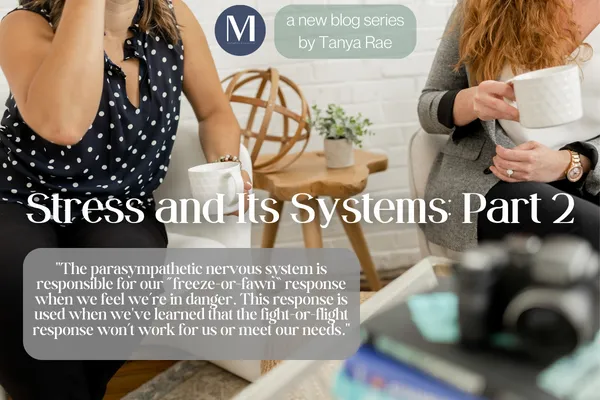the blog
A place for our team to share about topics they are passionate about, in hopes of allowing you to see and understand a bit more behind the faces on these pages.

Stress & It's Systems - Part Two
My last post spoke about our “fight-or-flight” stress response. As explained, our fight-or-flight response arises from our “sympathetic nervous system”. It's a part of a larger system in the brain called the "autonomic nervous system". This larger system also contains, what’s known as, the “parasympathetic nervous system”. I've included a diagram below to show the different systems, stress responses, and where they arise from.
The parasympathetic nervous system is responsible for our “freeze-or-fawn” response when we feel we’re in danger. This response is used when we've learned that the fight-or-flight response won’t work for us or meet our needs. Instead of active movements and actions like fighting or fleeing, the freeze-or-fawn response results in things like:
reduced heart rate,
heaviness in the body,
being frozen in place (freezing),
taking the blame or being very agreeable to avoid disconnection or harm (fawning)
Stay tuned to understand more about what these responses look like.
The parasympathetic nervous system is also responsible for, what’s known as, the “rest and digest” response. This is the response we want to tap into and practice engaging throughout therapy. With practice, we can learn how to calm down and come out of our fight, flight, freeze, and fawn reactions. This is an important skill to develop for addressing most concerns in therapy, such as: anxiety, depression, anger, trauma, relationship issues, etc. Once learned, it’s like a SUPERPOWER! This is because it allows you to CHOOSE to switch out of the part of your brain that's reactive, and into the part that allows you to think things through.
Instead of
fighting,
running away,
freezing
abandoning your needs....
You can begin to
think,
understand the situation,
understand your own and other's reactions,
choose a better response
With practice, this can all happen in a body that feels calm and collected. This is truly half the battle! With this ability in place, clients can begin to feel more in control of their life. They can start to feel safe enough to explore the underlying causes of their reactions and undesired outcomes in sessions. The practice of moving into our rest and digest response is done through relaxation and grounding exercises.
Til next time,
Tanya Rae
Office Location: 1200 Brock Street South, Whitby, ON. L1N 4L9
© Marquis Counselling & Consulting | ALL RIGHTS RESERVED | TERMS & CONDITIONS | PRIVACY POLICY
